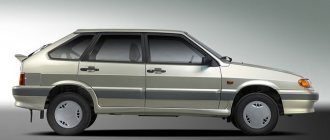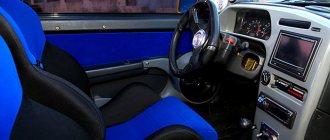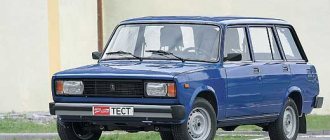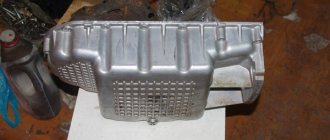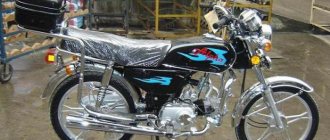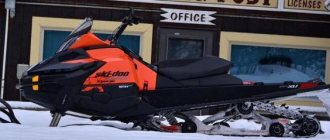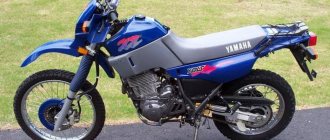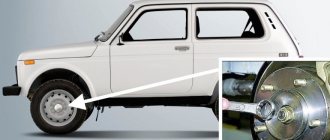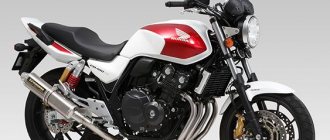Exterior
The appearance of the VAZ 2114 is not for everyone. Just like in the “ninth” family, “square body shapes” predominate here. A lot of broken lines completely deprived the car of grace, but added confidence and its own style to its appearance. The car has a large glass area, which provides the driver with good all-round visibility.
It is noteworthy that the VAZ 2114 is the only model of a domestic manufacturer whose door opening angle is 90 degrees. Agree, not every foreign car can boast of such convenience.
The front part of the “fourteenth” is expressed by large rectangular headlights, divided into two sections, a miniature radiator grille that provides the necessary volume of air to cool the power plant, and a neat bumper.
The wheel arches of the car look compact and appropriate: 13-inch wheels fit well into them. On later editions, the manufacturer provided 14-inch wheels.
Among the attractive exterior features are aggressive optics and short aerodynamic overhangs, which give the car good dynamic characteristics. The only inconvenience is the small side mirrors, which provide insufficient visibility to the driver. Special indignation is caused by door handles with a “tongue” that periodically does not allow the driver to enter the car.
The body of the fourteenth model consists of more than half of galvanized steel, the use of which was supposed to give the car anti-corrosion resistance. However, the hatchback did not receive this quality. As a result, drivers, in order to maintain the integrity of the car, have to periodically treat it with anticorrosive. Otherwise, through corrosion will very quickly render the vehicle unusable.
Car design
Initially, the VAZ-2114 was positioned as a youth car. The design of the “nine” was outdated by the time the fourteenth model was released. Therefore, AvtoVAZ adapted the appearance of the car to the needs of customers.
The car acquired a smoother silhouette and the famous narrow headlights, which became the “calling card” of the VAZ 2114. Wide moldings appeared on the outside sides, which were replaced with narrower ones in 2007.
The model is equipped with thresholds that are painted to match the body.
Changes were mainly made to the front part of the car. At the same time, the radiator grille and front spoiler are borrowed from the VAZ-2115. The rear part remained almost unchanged, retaining the distinctive features of the VAZ-2109.
The interior of the car has also changed. More modern faux leather and velor trim have appeared. According to reviews from car owners, the noise and rattling characteristic of the Nine have disappeared - this indicates improved sound insulation.
Salon of VAZ 2114
The “Lux” version is equipped with ashtrays for the driver and passengers, electric windows and central locking.
The developers also took care of the driver’s convenience. The steering column can be adjusted to the desired height, and the instrument panel is illuminated.
The Luxury package includes fog lights. Overall, the car received a more stylish appearance, while becoming more comfortable for both the driver and passengers.
Interior
In the interior decoration of the fourteenth model, the designers miscalculated a little with the materials. For example, the fabric used for seat upholstery wore out after just a couple of years of active use, which is why drivers always had to use covers. The hard plastic used in the control panel begins to creak strongly in the cold, which causes some inconvenience to the car's passengers.
Torpedo Lada Samara (2114) 2001–13
There is no need to mention the sound insulation of the VAZ 2114 - there is practically none in the car. Meanwhile, the interior of the hatchback is compact and laconic. All control devices are located near the driver. The center console is even turned in his direction for convenience. In front of the front passenger there is only a glove box and a niche for small items.
The cabin capacity is four adults. And only of average height. It will be extremely uncomfortable for tall people in the back seat: firstly, the low ceiling will interfere, and secondly, there is too little distance between the rows of seats for knees.
The main convenience of this hatchback is the folding rear row of seats. By folding it, the driver will receive increased luggage space.
Possible faults
Not the last argument for car enthusiasts when choosing a VAZ 2114 is its similarity to the “nine”. Having succeeded in repairing the latter, they hope to use their skills if the new car breaks down. A large number of nodes remained unchanged. This undoubtedly makes repairs easier, and in some cases cheaper. Over the ten years of operation of the VAZ 2114, some statistics of malfunctions have accumulated. After analyzing it, we can highlight the main ones.
Traditionally, and this applies not only to the Lada 2114, the absolute number of faults is related to the suspension. Of course, not all of them are due to design flaws or poor quality materials. Our roads are to blame for many.
And yet, the vast majority of car enthusiasts say that the car’s shock absorber struts failed after 30 thousand km. The problem is solved by replacing them with products from well-known manufacturers. Some car enthusiasts do this without waiting for the malfunction to appear. The next unit that most often caused problems for VAZ 2114 owners was the clutch. It was this that 40 percent of motorists had to repair.
In this case, malfunctions have almost nothing to do with operating conditions. The main reason is disk failure. The mass air flow sensor is a very common cause of engine failure in the Lada 2114. This usually happens when the air filter is rarely replaced and the compression rings are bad. In the latter case, the pressure in the crankcase increases and the mass air flow sensor becomes oily. In addition, sometimes the cause of the breakdown can be the car owner himself, who decides to wipe the sensor.
Engine modifications
Until 2007, the “fourteenth” model was produced with a 1.5-liter 8-valve gasoline engine producing 77 hp, which met Euro-2 requirements. In 2008, engineers installed a new control unit on the model, thereby increasing the environmental friendliness of the engine to the Euro-3 level. At the same time, 1.6-liter 8-valve units with 81 hp began to be installed in the car. The use of a new control unit entailed the need to replace the gas pedal: now an electronic system was used instead of a cable. The first batches of cars with an electronic gas pedal revealed many problems, which could only be resolved by the beginning of 2012.
Engine with a displacement of 1.6 liters.
Since 2008, engineers have slightly changed the design of the model: they moved the catalyst from under the bottom and installed it next to the power plant. This solution made it possible to protect the mechanism from damage when driving off-road by protecting the engine. In parallel with this, a new modification of the 1.6-liter engine with 16 valves and 89 hp was developed. power. The car received improved dynamic characteristics and 14-inch wheels.
It was possible to achieve Euro-4 environmental friendliness only in 2010, when Super-Auto CJSC prepared for production the “fourteenth” with an engine with a power of 98 hp, a volume of 1.6 liters and 16 valves.
In combination with all engines, a five-speed manual transmission was installed.
CAR HISTORY
As mentioned above, the production of the “14th model” lay at the Volzhsky Automobile Plant. The car, which was equipped with a new name “Lada 2114 Samara-2”, was created on the platform of the famous VAZ-2109. Many owners of “nines” are already tired of the outdated front panel, so the new Europanel is very popular among drivers.
Serial production of the domestic hatchback began in 2003. The Lada-2114 Samara was equipped with the already familiar four-cylinder eight-valve 1.5-liter power plant, which was able to prove itself well in the 2109 model. When 2007 arrived, the car underwent an update that affected the technical part.
The line of power units has been replenished with a brand new 8-valve 1.6-liter engine. The catalyst was now installed directly next to the internal combustion engine, and it also received a plastic housing. The changes also affected the dashboard. The company pleased drivers with the presence of an on-board computer. The glove compartment in the upper part disappeared, and the panel itself was finished with hard plastic.
After 3 years, specialists significantly modernized the VAZ-2114 in 2010. Now under the hood of the domestic hatchback there was a sixteen-valve power unit from the Lada Priora.
Thanks to cooperation with the Recaro company, it was possible to equip the car with new seats and suspension. Production of the Lada VAZ-2114 was discontinued on December 24, 2013. The “transitional” version, represented by the 14th model, was successfully replaced by a new version from Lada - Priora.
Options
The basic equipment of the VAZ 2114 cannot boast of wealth, however, it has everything that is so necessary for daily movement:
- height-adjustable steering column,
- the presence of an on-board computer informing about the remaining gasoline in the tank, average fuel consumption and power reserve,
- electric windows for front doors,
- inertia seat belts,
- full size spare wheel.
In the “Standard” configuration, an interior lamp, a mirror in the passenger visor and a combined steering wheel upholstery were added to the car’s equipment. In the maximum configuration, the car received fog lights, heated front seats, and adjustable headrests in the rear row.
On-board computer VAZ 2114
The luxury package was also complemented by 14-inch stamped wheels. The VAZ 2114 never had airbags, ABS and ESP systems, so this car cannot be called safe.
ADVANTAGES AND DISADVANTAGES
ADVANTAGES OF THE MACHINE
- Good aerodynamics;
- Pleasant appearance;
- Quite fast power plants;
- Acceptable ride height;
- In high esteem among the young population;
- Lots of possibilities for various improvements;
- Already the base car has a small and stylish rear spoiler;
- Front-wheel drive;
- Good stability;
- Bumpers painted to match the body color;
- Good wear resistance of the suspension;
- More pleasant europanel;
- There is an on-board computer;
- Heated front seats;
- Price;
- Electric windows;
- Cast wheels with the possibility of installing “rollers” of larger diameter;
- Adjustable steering column;
- Ease of repair;
- Low fuel consumption.
DISADVANTAGES OF THE CAR
- Door handles often fail;
- The bumpers are also very easy to break since they are plastic;
- The car rots very quickly, it is necessary to treat it with a primer yourself, since the manufacturing company missed this;
- There's not much space inside;
- Low level of security;
- No air conditioning or power steering;
- Poor build quality;
- Hard plastic front panel;
- Small luggage compartment.
Specifications
The technical characteristics of the car are presented in the table below:
| Options | Index |
| Length, mm | 4 122 |
| Width, mm | 1 650 |
| Height, mm | 1 402 |
| Ground clearance, mm | 160/165 |
| Front track width, mm | 1 400 |
| Rear track width, mm | 1 370 |
| Wheelbase, mm | 2 460 |
| Trunk volume, l | 330/600 |
| Weight, kg | 985 |
| Fuel tank volume, l | 43 |
| Load capacity, kg | 425 |
From 2001 to 2010, the car was produced with a ground clearance of 160 mm, but after modifications by Super-Auto JSC, the figure increased by 5 mm. One of the main advantages of the model is the ability to increase the luggage compartment from 330 to 600 liters, thanks to the folding rear seats.
Controllability
The car's handling is difficult to call ideal. Yes, it takes turns, confidently accelerates, but at the same time it has a noticeable play when turning the steering wheel, which is several times higher than the permissible values. The “fourteenth” has an independent spring suspension at the front, and a semi-independent spring at the rear.
Being a car passenger also has a hard time - due to the stiff suspension, all road irregularities are felt in the cabin. You won’t be able to drive the “fourteenth” off-road either – any “diagonal” will take the driver by surprise. This car is designed for city and highway travel.
Suspension and engine
The MacPherson design remains in front, and the semi-independent beam at the rear. But a reconfiguration will be made, which, together with body rigidity, will improve handling. The dynamic characteristics of the car also promise to be excellent. The curb weight corresponds to the Granta level.
As a power plant, the new nine will receive powerful 1.8-liter engines that will work with a 5-speed manual transmission. The basic version will receive a standard 122 hp engine. With. With it, Samara will be able to accelerate to hundreds in 9.5 seconds. This is an indicator of the expensive, charged Vesta Sport.
The top version of the new Samara Sport will receive a forced 1.8 engine from the same Vesta. It produces 145 hp. With. Acceleration to 100 km per hour in less than 9 seconds. The car can tear apart not only any of the other VAZ models, but also such competitors as the turbocharged Volkswagen Polo and Skoda Rapid. At the same time, the cost is noticeably less than the latter. Already in the base, the new Samara is equipped with disc brakes.
Competitors
The VAZ 2114 has had many competitors at all times, and many drivers were amazed: why, with such a variety of foreign analogues, many car enthusiasts prefer the domestic “designer”. It's simple: getting spare parts for foreign cars was often problematic. You can repair a VAZ using improvised means. However, among the competitive models, several cars should be highlighted. The first of them is the Chevrolet Lacetti. This nimble and attractive car has excellent dynamic characteristics, great endurance and rich technical equipment. Its design, developed by the Italian studio Pininfarina in 2002, is still relevant today. The car, discontinued in 2014, is still in high demand on the secondary market.
Chevrolet Lacetti
The Opel Corsa is another compact car, famous for its high engine life and excellent handling. From the outside it seems that the Corsa is cramped and uncomfortable, but when you look into the interior, you are pleasantly surprised - everything here is laconic and thoughtful. The history of the Opel Corsa began in 1982 and continues to this day. In the line of its generations one can trace the history of improving engineering. The manufacturer switched from broken lines to exaggerated futuristic design back in 2000, a year later AvtoVAZ released the “square fourteenth”. In 2006, an updated version of the Corsa was born - with huge headlights, stylish moldings in the front part and an elegant body bevel. In the VAZ 2114, in addition to engine modifications, there were no more significant changes until the end of production.
Advantages and disadvantages
It is advisable to include all the advantages and disadvantages of the model in the table.
| Advantages | Flaws |
| Automotive stores almost always have spare parts for the VAZ 2114 in stock, so the car can be repaired in the shortest possible time. | Lack of airbags and additional options to save the lives of the driver and passengers in the event of an accident |
| Due to its light weight, the “fourteenth” accelerates quickly and consumes a small amount of fuel mixture | Weak head optics provide poor visibility at night, fog and snowfall |
| Thanks to the expanding luggage compartment, a large amount of cargo can be transported inside the car | Low quality metal leads to rapid rotting of the car |
| With proper care of the machine, it functions properly in both extreme heat and severe frost. | No blocking, low cross-country ability on off-road and snow |
| Thanks to its small dimensions, it is very convenient to “check” the VAZ 2114 in city traffic jams | A cramped interior with a low ceiling, designed for only four people of average height |
| Large glass area provides good visibility on the road | A large number of problems with engines for models of any year of manufacture |
Reviews from car owners
Reviews from car owners will help you make a complete conclusion about the car’s reliability.
“I purchased a VAZ 2114 in 2004. By those standards, the car was fresh and stylish. But somehow it grew old too quickly: in the second year of operation, the engine liners were wrapped. Invested there. Then the exhaust pipe burned out. Replaced. Then the door handles began to break. This is generally the weak point of this unit. In winter, snow freezes under the tongue - until you push it off, you won’t get into the car. In summer, this tongue falls inside the handle, which also prevents access to the interior. I suffered a lot and invested a lot of money in the car. Finished off by the appearance of through rust in the bottom of the car. I always kept it clean, kept it in the garage, and did not go off-road. And here is the result: corrosion. I sold the “fourteenth” 5 years after the purchase and now I don’t even want to look in their direction. A real designer."
Yaroslav, Orenburg
“For me, the “fourteenth” is a real workhorse. For more than ten years now I have been making money from it: I take vegetables to the nearest city to sell. Because All spare parts for the car are inexpensive, repairs allow you to save money. It is roomy, easy to control, and starts reliably in cold weather. I have a basic configuration and the simplest engine - 1.5 liters. It is not a pity to use it to its fullest extent, and so far it copes with its tasks quite easily. A couple of years ago I only noticed that the body began to rot. I took it to a service center, painted it, and now the car looks like new. There were problems with the engine, but I fixed them myself.”
Pavel, s. Yantishevo
“I have no confidence in this car. My son bought it not long ago. The copy seems to be fresh - 2011, but inside it is like being in a tank. The engine is very loud, the suspension rattles, and there seems to be no sound insulation at all. It is unsafe to drive such a car - it will fall apart at any moment. He bought a car to work as a taxi, but he already invested more into it than he earned. And he’s even a little ashamed to transport passengers in this “domestic carriage”. Now the fourteenth one is in the garage - its starter has once again failed. Selling such a car further is a real crime. The only way out is to sell it for scrap.”
Inna, Tyumen
“I’ve been driving a 2010 VAZ 2114 with a 1.6 engine for four years now. I actively use the car and am amazed at how durable it is. Yes, there were problems with the power plant, but they were all easily resolved. On the fourteenth, my family and I go to nature, visit relatives 300 km away, and it always functions properly. On light off-road conditions, the car obeys the steering wheel and does not slip. It also handles quite confidently on a snowy track. There have been times when I got stuck in the winter, but this problem is common to all front-wheel drive cars. The only significant shortcomings of this machine are in the electrics. In severe frost, the rear lights periodically stopped working. I had to tinker with the wiring, rewind the wires and now the optics work properly. I recommend the car to those who like a quiet, measured ride and are not afraid to repair the car themselves.”
Andrey, Ekaterinburg
Summarize
LADA Samara was popular in the early 2000s due to its low cost, maintainability and novelty. They bought it because... It was difficult to find a foreign analogue in good condition. However, now there are no problems with competitors - they are all available in abundance on the secondary market. It’s hard to say what makes car enthusiasts buy domestic “fourteeners”. Possibly savings. Perhaps a desire to support AvtoVAZ.
However, in any case, when purchasing this car, it is worth remembering that it is no different in safety and reliability. And it is better to give preference to foreign competitors in which manufacturers have invested at least minimal options to ensure safe movement. Especially if you plan to use the vehicle to transport passengers. Savings are not appropriate here.
